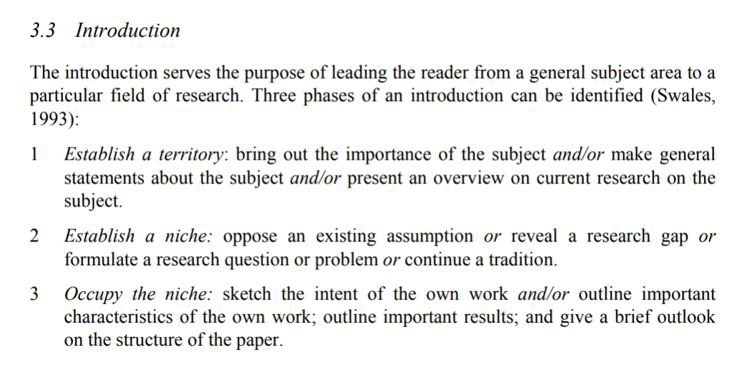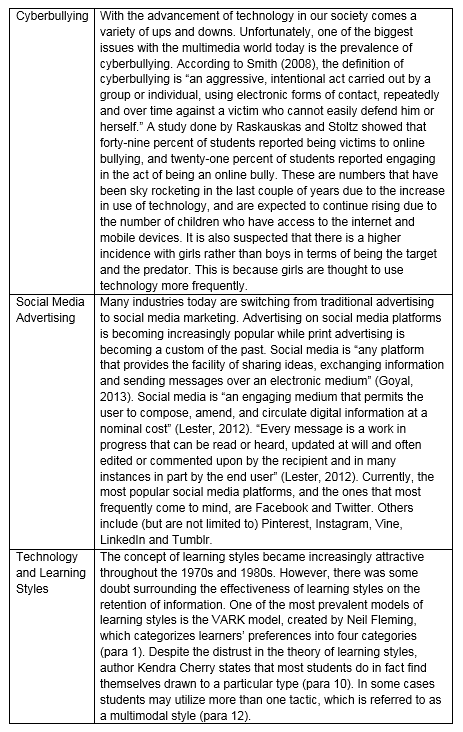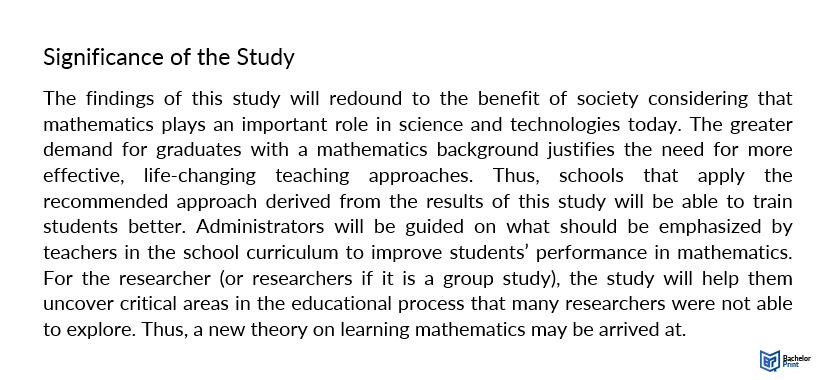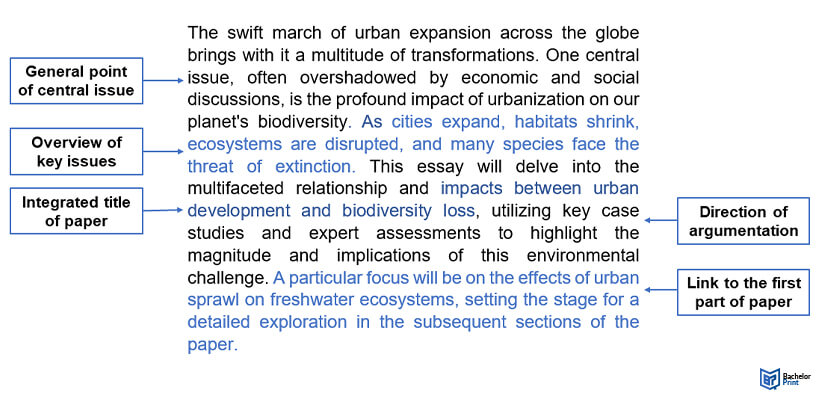
In the sphere of academic writing, the introduction holds a significant section in many types of papers ranging from academic essays to historical papers, serving as a crucial framework that provides insight into the core essence of the entire paper. An ideal introduction engages the readers, sets the tone, and includes a thesis statement, which navigates the following discourse. Crafting a compelling introductory paragraph poses an essential writing skill to improve your writing style and initial impressions of a paper.
Definition: Introduction
There are several definitions for introductions. The general one is that is at the beginning of all kinds of papers and poses an essential framework. The functions of introductions are, among others, to smoothly transition the readers into the core of the entire paper. Therefore, it forms one of the three cornerstones of many types of paper in the academic realm, next to the main body and conclusion.
A concise, engaging, and well-written introduction skillfully makes the reader excited and draws their attention to the topic by arousing interest. The introductory paragraph also needs to describe the objective of your paper and state the methods you will use to achieve your goal. It entails a sneak peek into the theoretical or empirical framework, as well as, the methodology of the paper. Moreover, it houses the rule of thumb for thesis statements, which presents a crucial role in guiding the arguments and discourse that follow. Oftentimes, the introduction includes thesis acknowledgments regarding existing literature, i.e., it provides contrasts or alignments between the study and already existing studies surrounding the same or similar topics. This plays an imperative role in contributing to the overall academic debate on the topic.
Contents of an introduction
The background for context, sentence structure, and putting ideas in context are critical aspects to consider when aiming to draw attentive readers and composing an effective introduction. Effective strategies for a good introductory paragraph are to fulfill relevance, research topic, and procedure:
- Relevance: Why is the research topic important? Hook the reader!
- Research topic: What is the research question and/or topic matter that will be covered?
- Procedure: What effective strategy should be used to answer the research question?
In short, the introductory paragraph initiates the topic matters for the area of research, as well as the research question, derived from it. A well-written introduction tells the reader why answering the research question will lead to new, important insights.

Paper outline of methods
Equally important is the essay outline of the methods used to answer the research question.

In the introductory paragraph, you need to justify how and why you have narrowed down your topic. This will be summarized by a shorter introduction and description of your line of argument and the structure of your research paper.
Tip: Make sure not to turn your introduction into a simple reproduction of your table of contents.
Like the concluding paragraph, the introductory paragraph of your bachelor’s thesis should not represent a fragment, but a constant introduction. This means that sweeping statements should be avoided so that the reader does not need to rely on insights established within the main body to understand the topic of the paper.
Overview of structure and key aspects
| Steps | Aspects of writing an Introduction |
| Step 1 | Leading to the topic |
| Step 2 | Justification of the topic’s relevance |
| Step 3 | Subject of your research paper or academic essay |
| Step 4 | Objectives of your research paper |
| Step 5 | Outline of methods |
| Step 6 | Limitations of your research questions |
| Step 7 | Differentiation and disambiguation of terms |
| Step 8 | Structure of your research paper or essay |
Find more detailed information below by clicking on the relevant aspect.
Step 1: Leading to the topic
There are numerous ways to eager readers to your research topic:
- A provocative proposition
- Thought-provoking questions
- An experiential report
- A puzzling scenario
- A quote
Note: Most of the time, well-known or famous quotes don’t work in academic papers, quote an author of a reference or source instead.
Structuring an introductory paragraph
- Introduce the general context or background: Perhaps you could explain the title in your own words or use a quotation from an author who offers a supporting or contradictory statement about your topic area.
- Definitions: Are you using any complex terminology or acronyms that need definitions? Try to use a working definition from an expert in your subject area, rather than referring to broad statements of a dictionary.
- Introduce the ideas in context: You cannot include everything, e.g., in a 2000-word English essay introduction; select between three and five key ideas and introduce them in the order they are discussed.
Step 2: Justification of the topic’s relevance
The introductory paragraph of your thesis or research paper contextualizes your overall topic within the greater context of the area of research and establishes a connection to other studies in the general field.
The following three introduction paragraph examples are guidelines as to how you can best tie in with the most current research:

The following example illustrates how you can point the reader to your topic’s significance:

This significance of the study starts off with broad statements and gradually tapers off to a specific group or person. In essence, it delves into the general contribution of the study like the importance of this study to society as a whole, and then proceeds towards its contribution to individuals including yourself as a researcher.
Step 3: Subject of your research paper or academic essay
When writing the introduction to your research paper or your academic essay, it is crucial to touch upon what will be researched.
This can be done by addressing your research question. Keep the aspects in mind, you will be narrowing your research topic down to, and what definition of the key terms used in your research question you want to follow.
The research question is a product of your topic in research, which is why it needs to be evident and clear that there is a relationship between the question and the topic throughout your entire paper.
Step 4: Objectives of your research paper
Other vital aspects to include in the introductory paragraph are the objective you are pursuing, and the outcome you are anticipating.
The title of your research paper is not identical to your objectives. Typically, the title of your research paper or essay describes the general subject area rather than the niche you want to cover.
The introduction paragraph examples below show how to account for the objective of your paper in one sentence.
Step 5: Outline of methods
Writing an effective introduction also involves having a firm grasp of the methods you will be using to achieve your research goal. For this, you must depict the way you anticipate achieving your objectives in the introduction paragraph of your essay or research paper and how you went about to answer the research question.
Furthermore, a summary of the theoretical framework of your research paper is an essential part of the introduction, including the literature review.
In terms of empirical research like a dissertation based on empirical studies, the introduction needs to explain the methods utilized to analyze the data you gathered in your study and the proceess behind it.
Related background in the introduction paragraph, such as work experience or research stays, is a plus when it is appropriate. However, this information should only be used if relevant.
Step 6: Limitations of your research questions
Acknowledging your limitations plays a crucial factor in writing an effective introduction for your research, as they dissociate your research topic from other studies in the field.
Therefore, giving valid reasons for any limitations and restrictions makes your research unique and different from others. The introduction paragraph of your research paper clarifies why you restrict your research topic to a certain, potentially very specific research area, and why this is important to achieve the goals you set out to, whether this pertains to a bachelor’s thesis, or any other research paper.
Step 7: Differentiation and disambiguation of terms
If you use specific terminology in your research paper, it is integral to include a section explaining these fundamental terms in your introduction, so the readers can grasp a good understanding of your reseach topic.
Explanations of terms that are only relevant to individual segments of your research paper should not be part of the introduction paragraph. Focus on terms that you might use (slightly) differently than your readers might expect, and define them accordingly.
Step 8: Outline of the structure of your research paper or essay
Based on the table of contents of your paper, it is essential to provide a brief outline of the paper’s structure in the introduction. The outline should contain a clear representation of argumentative choice.
In essence, you give a short overview of how you will go about answering your research question, which is reflected in the structure of your research paper. This will also be helpful to keep the reader excited and attentive for the following discourse.
Note: As a rule of thumb, the quality of the explanations depends on the length of your research paper: The shorter your research paper, the shorter your initial explanations in the introduction paragraph.
Keep in mind that the main goal is to keep the reader hooked and provide a thorough understanding of why you have chosen to proceed a certain way.
numerous advantages for Canadian students:
- ✓ 3D live preview of your configuration
- ✓ Free express delivery for every order
- ✓ High-quality bindings with individual embossing

Examples
The University of Leicester gives an example of an effective essay introduction. Be aware that essays are a particular kind of research paper and differ from, e.g., articles or ‘scientific’ term papers. The example below illustrates the sections of an introduction regarding the following research question “What is the importance of imitation in early child development?”

Thesis introduction
„We want a story that starts out with an earthquake and works its way up to a climax.”
Samuel Goldwyn, film producer and publisher.
While a scientific research paper is not a film script and no professor will expect an earthquake when sitting down to read the introduction paragraph of your research paper, you still want to achieve a similar mind-blowing effect with your introduction.
Your introduction paragraph needs to captivate the reader and arouse curiosity. It is the initial impression of your paper, and therefore, should not make a negative impression. A catchy introduction guarantees that the reader will keep reading your paper with interest.
The introduction paragraph is the actual beginning of your paper, as neither the abstract, foreword, nor table of contents belong in the actual body of it.
In the introduction paragraph, you reach out to the reader for the first time, and ideally, you want to leave a good impression. Thus, the introduction poses the flagship of your research paper.
Length of the introduction paragraph
Planning your writing is quite a pragmatic endeavor. This includes deciding on how long each part of the text needs to be. The lengths of individual parts of your research paper depend on the overall length of your paper.
While the main body of your research paper should be the longest, the introduction paragraph should account for up to 15% of the scope of your text. It is advised to restrict the introduction down to only 5%, which is the equivalent of approximately one page in a 20-page research paper. Some institutional guidelines advise 10%, therefore, depending on your institution, this may vary.
In overall, the introduction paragraph of your research paper, essay, or dissertation should account for 5-15% of your paper. It is further urged to write your introduction paragraph in such a manner that it holds a sensible relation to the rest of the text. Writing an effective introduction is not an easy task just because it is comparatively short. Be brief but precise, boil everything down to its essence, and save the longer versions of explanations for the main body of the text.
Note: The introduction does not anticipate the main body. Instead, the introduction announces the content of the main body. In other words, the introduction paragraph paves the way into the main body of your paper. As an announcement, the introduction needs to be to the point by definition.
Introduction vs. closing paragraph
Where to start on that blank piece of paper in front of you? As ironic as it might sound, it is a just and well debated question. The introduction paragraph and the closing paragraph are closely linked. While the closing paragraph summarizes the main body of your research paper, the introduction paragraph prepares the reader for it. Hence, both conclusion and introduction are part of brackets that parenthesize your research paper.
Essentially, you should write the introduction paragraph at the end of your writing process. This is because you are likely to know only at the end of your work what you could actually achieve. Therefore, it is recommended to write a rough draft at first and complete the initial introduction along the way.
Writing an introduction is considered the most difficult part. Therefore, it is efficient to write a rough draft at first and finalize it once you know where you are headed. The first step of the writing process, should be the main body. This strategy can also prevent writer’s block. Adding an appropriate quote that gets the reader started and is then followed by the research discourse and a research question is an effective way of beginning your writing process.
It is also imperative that you have gained a thorough overview of your research topic prior writing your introduction, especially for more complicated topics, to captivate the reader.
Don’ts for writing a good introduction
The following table summarizes important aspects you should refrain from when writing your introduction:
| Don’ts | Examples |
|
Limitation of research topic is not justified scientifically: If you limit your paper to certain aspects, it is vital to explain your (scientific) reasons for doing so in the introduction paragraph. Limiting your research indicates that you have a good grasp of the general research area as well as your possibilities in the realms of your Bachelor's thesis or essay. |
“The topic of the philosophy of science is a wide-spread subject. As a result, an analysis of various scientific theoretical approaches will be refrained from in this paper.” |
|
Refraining from further analysis because something is too complex: “[…] is beyond the scope of this paper” does not add anything important to your argument. What follows from refraining from mentioning certain topics/outlines? |
“The group of themes concerning the relation between the Polish minority to German parties; the role of the Polish questions in the Prussian House of Parliament; the Polish banks in Berlin etc. have been used during research, but the respective descriptions would have been beyond the scope of this paper.” |
|
Justify your personal interest in the matter or making a personal confession: Science is not about beliefs, and your personal conviction is no justification for your bachelor thesis. |
“My preoccupation with the works of Toni Morrison stirred up many emotions in me. The more I exposed myself to her work, the more complex my picture of the author and her work turned out to be.” |
|
Recounting the table of contents: What is the sequence of the chapters? This does not need to be recounted but explained. |
“Chapter six deals with the developed prototype. Single models of domains of prototypes and their points of intersections will be explained. What follows is a description of the implementation and possible extensions of the prototypes. The paper will conclude with chapter seven, which will provide an outlook |
The introduction does not anticipate the main body, it rather announces the content of the main body. Hence, the introduction paragraph navigates the reader to the main body of your research discourse. Based on this, the introduction needs to be short and precise by definition.
FAQs
- Understand the purpose: Background and thesis statement
- Start with a hook: Anecdote, question, quotation, statistics, bold statement
- Tailor it to your audience: What is the target group? What do they know already?
- Revise and refine: Complete it along the way, finalize it at the end of writing
An introduction primarily states the purpose of an academic paper. It conveys the central or main points that will be covered. The thesis statement should be placed towards the end of the introduction, with any background information given beforehand. Introductions come right after the table of contents page, but before the body of the essay or thesis.
Click here to get to the example.
An introduction of any scientific paper represents the beginning part of the paper, where you provide basic information to transition the reader to the main discourse of the paper.
Every introduction should clearly state the purpose of your paper with a summary of the main points that will be discussed. It should be enough to give the reader an overview of what to expect in the main body of the writing. It can also include an explanation of elements that are not mentioned within the scope of the remaining writing, such as background information that may be relevant to the thesis statement. The thesis statement should always be placed towards the end of the introduction.
A good introduction captures the reader’s attention immediately, which in turn makes them want to read the remaining pages of the paper. It should clearly state the main topic, provide relevant context, and explain your specific area of focus. Ultimately, it should provide the most relevant and helpful information about your research topic. The reader should be informed of any background information prior to reading the body of the thesis or essay.
The main difference between an introduction and a summary is their purpose. The introduction gives the reader a brief description of the topic and the main ideas that will be covered. A summary, on the other hand, briefly explains everything that is covered in a text in a few condensed sentences. Therefore, a summary is more general while an introduction points to the main topics and relevant ideas of the academic text.
